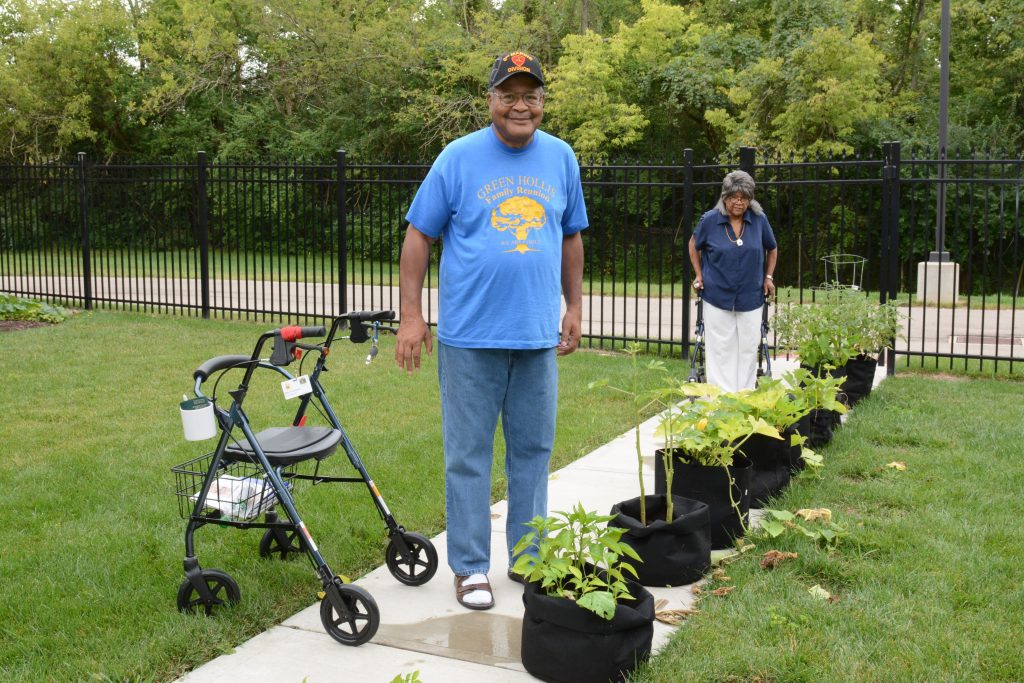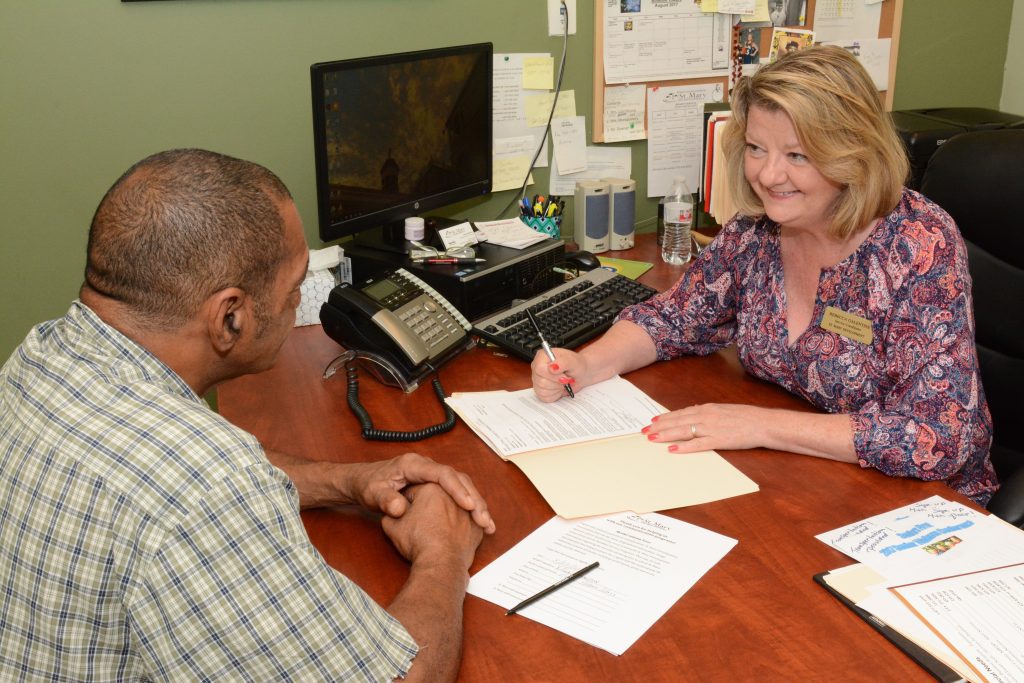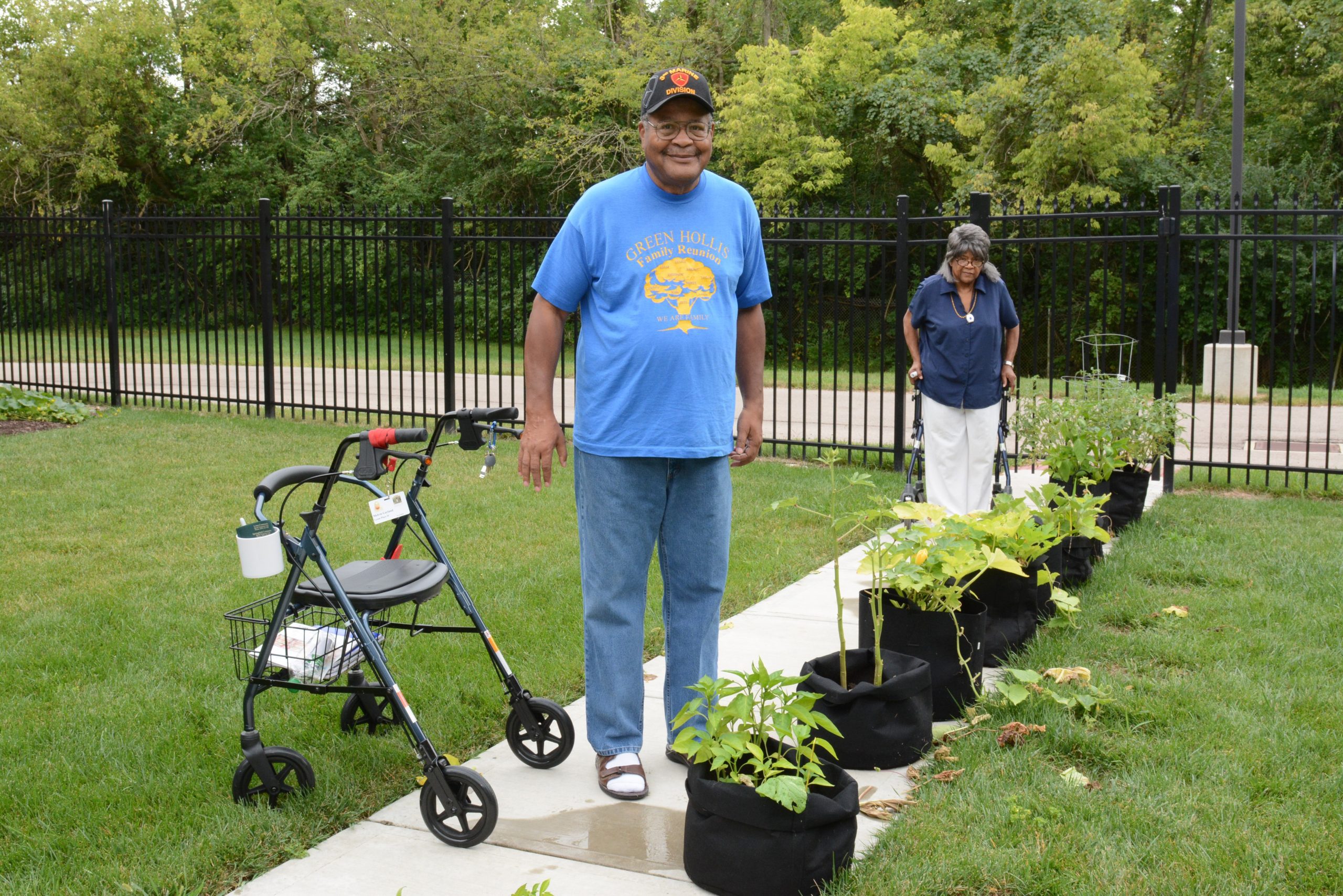
Residents of Lyons Place II, a Dayton, Ohio, property that houses older adults, with vegetables they grew. Photo courtesy of St. Mary Development Corporation
Even catastrophes can come with lessons.
“Sometimes we get in this rut where we do work because that’s how we always have done it. COVID-19 really shook that, in a good way,” says Natalynne Baker. She’s the senior vice president and chief operating officer of St. Mary Development Corporation, which provides housing and services to low-income seniors in Dayton, Ohio.
For many Americans, COVID-19 prompted a reexamination of how they spend their time, their broader goals, and their purpose in life, resulting in the “great resignation” and a slew of individual relocations.
That reexamination of purpose has happened at the community organization level as well. St. Mary’s staff, which struggled during the pandemic to meet residents’ varied needs, found that the effort refocused them on how to best help their main constituency.
St. Mary wasn’t alone. NeighborWorks, a network of almost 250 community development groups around the country, including St. Mary, surveyed a number of its constituent organizations about their experiences during the pandemic and found that a large proportion of respondents had created new programs, forged unconventional partnerships, and developed broader strategies, while ensuring that the services they provided fit into those strategies. These approaches, the report says, “seek to improve outcomes for entire communities, not just for individuals that participate in specific programs.” For many of the groups, the changes are persisting—at least for now.
Meeting Residents Where They Were
St. Mary Development Corporation was founded in 1989 with a goal of developing and managing affordable housing properties, particularly for seniors. While the group has provided wraparound support and services for residents for many years, those offerings had long been considered secondary to its affordable housing work.
“We always focused on the social determinants of health,” says Baker, pointing to St. Mary’s partner organizations that have provided residents with food, transportation assistance, and other services. For many years, she and her colleagues had referred residents to those groups, but St. Mary staff rarely went beyond that basic intermediary role.
Still, it seemed to be working fine. Property managers would hold office hours so that residents with problems or needs could talk to someone in person, and a staff member would then connect them with the appropriate community-based service provider. But most residents rarely came in.

A resident of Biltmore Towers, a Dayton residence for disabled individuals and older adults, speaks with a St. Mary supportive services staff member. Photo courtesy of St. Mary Development Corporation
COVID changed the model. “We didn’t want those high-risk individuals coming into the office,” Baker explains, so the staff immediately shifted to a phone-based outreach system, calling every resident once a week. While St. Mary’s team had formerly prioritized face-to-face meetings, phone conversations turned out to have some huge upsides.
“A whole lot can be done over the phone,” says Baker. From a resident’s perspective, she says, “I’m in the privacy of my own home. I might’ve not wanted to walk down the hall to talk, but this way, even in my PJs I can have a conversation with a service coordinator.”
Speaking with every resident every week led to some revelations. The farmers’ market that the staff had been touting to residents? For people without cars, it required taking two buses—a challenge for someone using a walker. Similarly, partner organizations had provided residents with nutritional information, but it wasn’t always tailored to people living on limited budgets. And staff learned that the Wi-Fi being installed in the organization’s buildings was useful, but not sufficient; to recertify their housing, for example, residents needed to print out their Social Security statements, and public printers weren’t available at the sites.
“COVID allowed us to dig a little deeper,” says Baker. She and her colleagues realized they could have a greater impact on residents’ lives, and began acting as advocates, explaining to their community-based partners what they’d learned.
In many cases, it meant asking those partner organizations to come to the residents, rather than the other way around. For instance, St. Mary staff realized that if they encouraged the food pantry to visit on a regular basis, a diabetic resident might pick up some healthy food to take to their unit, rather than purchasing “Little Debbie snacks,” as Baker puts it, from a nearby convenience store. Similarly, in the past, a vision-impaired senior applying for transportation assistance might spend two days wading through the application himself, eventually asking for help in embarrassment—or simply giving up. But there would be a much greater chance of success if the transit organization came to him and helped him fill it out.
That perspective was useful when Dayton initiated free COVID testing and, later, vaccinations. The city was providing drive-up testing at the University of Dayton Arena’s parking lot, and residents who relied on public transit found it difficult to utilize. “And do you really want to send 80-year-old Ms. Betty on the bus if she might have COVID?” Baker says. St. Mary’s staff worked with the local Area Agency on Aging to coordinate door-to-door testing at their properties instead. Similarly, when vaccines were available, they enlisted a Rite Aid pharmacy to bring the shots to residents.
When COVID forced life to move online, staff tried to meet the residents where they were. For those who were interested, they offered free Amazon Echo speakers and tutored them one-on-one on how to interact with Alexa, or how to better use other devices.
St. Mary’s new goal was to examine residents’ needs more closely and abandon a one-size-fits-all model. Baker and her colleagues were increasingly seeing these services as not only useful programs but key components of a holistic healthcare strategy. After all, loneliness and social isolation have increasingly been linked to negative health outcomes, and food and transportation—along with housing—are crucial social determinants of health.
Today, COVID is no longer considered a public health emergency, but Baker says that the more tailored, personal approach will persist, and staff will continue relying on residents’ input. In part, it’s a financial issue: like many other groups around the country, the organization is struggling with staff shortages, and there’s no point in devoting employee time to an ineffective program. Baker says she and her colleagues continue to challenge their partner organizations to do a better job of meeting residents’ actual needs. And while the universal weekly calls have fallen by the wayside as in-person meetings have resumed, staff are now quick to telephone residents if they haven’t been seen in a while.
Prioritizing Small Businesses and Advocacy
Across the country, DevNW, an Oregon-based community development group, also came out of the pandemic with a new approach to its work—but for very different reasons.
DevNW is a young organization. Formed on Jan. 1, 2019, it’s the product of a merger of two longtime community development nonprofits, Neighborhood Economic Development Corporation and Willamette Neighborhood Housing Services. Serving a total of six adjacent counties in the state’s northwest corner, both groups had been focused on housing and neighborhood revitalization, and gradually their leaders realized that they could accomplish more by joining together.
“We were understanding that the communities [we serve] face multiple and layered issues, and we needed multiple and layered services,” says Emily Reiman, DevNW’s CEO.
Reiman and her colleagues told themselves that 2020 would be their chance to determine DevNW’s specific identity and figure out “how we wanted to show up in the world,” as Reiman put it.
Then, of course, COVID arrived. The group couldn’t focus on defining its identity and objectives the way its staff had hoped; they had to shift into emergency response mode. But it was clear that some activities had a bigger impact than others, influencing the organization’s longer-term priorities.
Housing, for example, had long been both groups’ North Star, and DevNW planned to continue in the same vein. But COVID elevated the importance of the organization’s business and financial programs. DevNW partners with an affiliate CDFI, Community LendingWorks, to provide small-business, consumer, and micro loans to individuals who struggle to access capital through traditional avenues. Its borrowers are disproportionately low-income, female, rural, and people of color. The small-business community in DevNW’s region was deeply affected by COVID—and yet those demographics, particularly independent contractors and Black entrepreneurs, wound up receiving less pandemic-related government assistance.
That made DevNW’s role even more crucial. The group was well-positioned to channel assistance and emergency funds to small grassroots businesses in the communities it serves, and it stepped up its lending activity. Pre-COVID, Reiman says, the organization lent between $2 million and $3 million in an average fiscal year; in 2021, it granted over $14 million in emergency loans.
“We got a very stark illustration about how important small businesses are to the economic health of the region we serve,” says Reiman. That lesson shaped the organization’s plans for its future. “It was very clear to us that we needed to play a role in helping to stabilize and build the micro and small business community, as both an asset for the individuals and the collective community.”
In response, the group has reexamined its lending procedures and underwriting criteria so that the organization and its CDFI partner can better help prospective borrowers, even if clients’ financials and credit scores are less than ideal.
“It’s really about taking more organizational time and investment with a person to say, ‘How can we get you on the path to a yes in six months or a year? We’ll continue to work with you and support you in your business development,’” says Karen Saxe, DevNW’s director of policy, advocacy, and strategic partnerships. “We’re really talking them through that, not just looking at their scores.”
Perhaps the most significant way that COVID affected DevNW’s work was on the policy front. During the pandemic, Oregon’s legislators held several special sessions to determine whether to provide assistance to renters and property owners, and if so, how much funding to allocate. Feeling that their on-the-ground work gave them some expertise, the group’s leaders weighed in.
“We worked with our legislative allies to say ‘both/and’: that we need to support tenants, but also landlords and homeowners,” says Saxe. They were successful. In late 2020, the state legislature allocated $200 million in rental assistance for both tenants and landlords, and added another $100 million in late 2021.
That experience stuck with the organization. “It reinforced for us that a legislative and policy approach is really necessary” for the group to effectively help lower-income communities, says Saxe. In February 2023, Saxe, who was formerly DevNW’s chief program officer, took on a full-time role as its policy and advocacy leader. “We know that as an agency, it’s wholly insufficient for us to not engage where decisions are being made. We need to talk about real-world impacts and how decisions reverberate.”
Saxe says that elected officials—local, state, and congressional—have welcomed DevNW’s input and maintained ongoing communication. That’s critical. After all, she says, “Not everyone recovered”—and that’s a message elected leaders need to keep hearing.






Comments